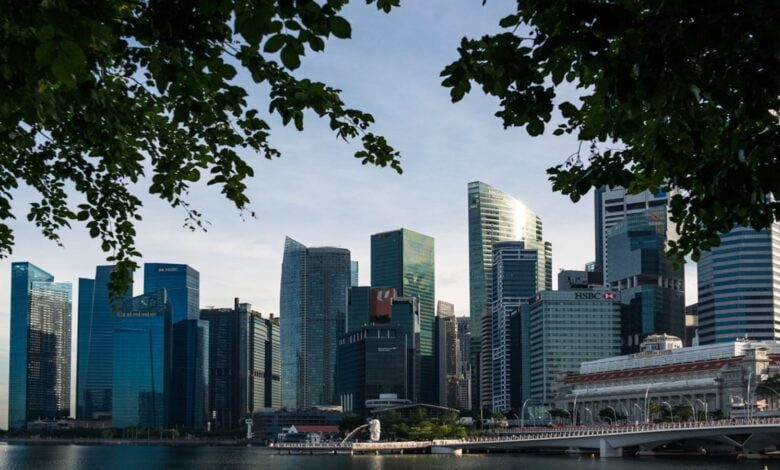A global recession is another planet for Singapore and has become a success for the economy

A global recession is another planet for Singapore and has become a success for the economy
Asian norms were early for the city reopening. state’s It has resulted in both a boom and some difficulties. It’s hard to spot warning signals of an impending global recession in Singapore, a little city so closely entwined with the ups and downs of finance. The city-state is once more importing immigrant labor, which is causing the unemployment rate to drop to minuscule levels.
The national airline is making huge profits, and the rise in rentals is astounding. The global slowdown frequently seems to be taking place on another planet. As much as the phrase “bubble” conjures up images of a terrible impending collapse, the real question may not be whether Singapore’s economy has become one, but rather how long the country can resist the laws of physics.
The end of an extended period of low inflation and interest rates, the need to control supply chains, and the escalating competition between China and the US are among the major trends that officials have warned will provide significant problems. For a nation that became wealthy in the heyday of globalization and the rise of the capital markets, this is — theoretically speaking — dreadful stuff.
A lot will depend on COVID-19 and its outcomes as to when and how this will reach Singapore. the advantage Singapore has over competitors upon its reopening. The city-state has abandoned nearly all of its military forces after a few false dawns. In August, indoor masks became optional. There is seldom a week when Singapore does not hold at least one significant international conference. Testing travel regulations is still a problem for Hong Kong. A mass departure has been brought on by the territory’s intransigent attitude as well as the national security law enforced by Beijing. It’s difficult to attend any type of social or professional function in Singapore without running into some people who have fled.

Singapore is taking full use of its early advantage. The latest quarter saw a large increase in the gross domestic product, a drop in the total unemployment rate to 2%, and the greatest inflation in 14 years. In a little more than a year, the central bank has tightened policy five times and combined its efforts to thwart price increases with concerns about the state of the world economy. The Monetary Authority of Singapore issued a warning last month: “In the quarters ahead, the pressure on economic activity from the globally coordinated tightening in monetary policy will accelerate.”
The price of housing reflects the gravitational attraction of the city-state. Large price and rent markups are a common subject at dinner parties. One of your columnists’ rents will increase by 30% when the lease on a three-bedroom flat is renewed in the early part of next year, and he could be among the lucky ones. The property is put up for sale without ever getting inspected. People have been surprised by someone offering much more after they believed they had secured a deal. Colleagues are relocating to larger, more affordable houses in Hong Kong.
Do authorities need to intervene because the real estate market is so hot? If there were no connections to public housing, it may be justified to keep your hands off. Housing & Development Board (HDB) flats, which make up the majority of Singaporeans‘ wealth, are home to about 78 percent of resident households. The government must mediate between the conflicting needs of affordability for the young and prosperity for the middle-aged and elderly, making HDB pricing a difficult subject.

Pent-up demand was forced into the HDB resale market as a result of the pandemic lockdowns messing up the delivery of new public housing. For six consecutive quarters, prices have increased at rates of 10% or more annually. If you think of the boom from 2007 to 2011, this isn’t concerning. In those days, over a five-year period, apartment prices increased by 80%. Over the previous two years, they have grown by a total of 25%. The pre-Asian crisis craze of 1992–1996 when HDB resale prices doubled is nowhere to be found in any episode.
But civilization in the city-state has advanced since then. In contrast to 30 in 1990, the median age last year was 42. The current age is likely to be more opposed to the prospect of a protracted real estate market decline than the younger pre-crisis generation. The government will thus exercise caution in deciding how much speculative activity to permit. Singapore’s toolset has included “property cooling measures” alongside monetary and fiscal policy since the global cheap-money regime began in 2009. If the prices of HDB resales don’t decrease, anticipate them to continue into a time of austerity.
There are a number of reasons why decision-makers could take action sooner rather than later. The present inflation problem is a big one, to start. The domestic labor market is tight, despite the fact that most price rises occur in the tiny, open economy with imported products and services. As they spend S$3.56 billion ($2.5 billion) to assist families with this year’s higher cost of living and S$8 billion to assist them with higher consumption taxes from next year, authorities won’t want to make their task more difficult by allowing an unabated rise in housing prices and rent to develop into a wage-price spiral.

With this political backdrop, the hand-wringing of foreigners over chardonnay and lattes in upscale cafés downtown is of little consequence. However, the prosperity of the nation has always depended on its standing as a regional hub for big businesses and on its ability to maintain that position. Property is only one aspect of this. The island offers top-notch infrastructure, low crime, and excellent schools.
Has Singapore made a lot of good decisions, or has its competitors missed a trick? It committed blunders during COVID-19 and had its share of policy U-turns, like most places. However, the farther you get from Singapore, the simpler it is to overlook its glaring flaws. It is sufficient to deal with the boom that COVID-19 has left the city-state.
edited and proofread by nikita sharma




